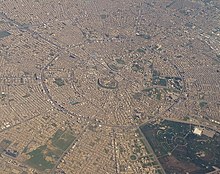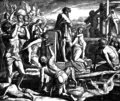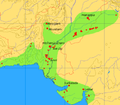Portal:Cities
The Cities Portal

A city is a human settlement of a substantial size. The term "city" has different meanings around the world and in some places the settlement can be very small. Even where the term is limited to larger settlements, there is no universally agreed definition of the lower boundary for their size. In a narrower sense, a city can be defined as a permanent and densely populated place with administratively defined boundaries whose members work primarily on non-agricultural tasks. Cities generally have extensive systems for housing, transportation, sanitation, utilities, land use, production of goods, and communication. Their density facilitates interaction between people, government organizations, and businesses, sometimes benefiting different parties in the process, such as improving the efficiency of goods and service distribution.
Historically, city dwellers have been a small proportion of humanity overall, but following two centuries of unprecedented and rapid urbanization, more than half of the world population now lives in cities, which has had profound consequences for global sustainability. Present-day cities usually form the core of larger metropolitan areas and urban areas—creating numerous commuters traveling toward city centres for employment, entertainment, and education. However, in a world of intensifying globalization, all cities are to varying degrees also connected globally beyond these regions. This increased influence means that cities also have significant influences on global issues, such as sustainable development, climate change, and global health. Because of these major influences on global issues, the international community has prioritized investment in sustainable cities through Sustainable Development Goal 11. Due to the efficiency of transportation and the smaller land consumption, dense cities hold the potential to have a smaller ecological footprint per inhabitant than more sparsely populated areas. Therefore, compact cities are often referred to as a crucial element in fighting climate change. However, this concentration can also have some significant negative consequences, such as forming urban heat islands, concentrating pollution, and stressing water supplies and other resources. (Full article...)
Selected city -

Tripoli, historically known as Tripoli-of-the-West, is the capital and largest city of Libya, with a population of about 1.317 million people in 2021. It is located in the northwest of Libya on the edge of the desert, on a point of rocky land projecting into the Mediterranean Sea and forming a bay. It includes the port of Tripoli and the country's largest commercial and manufacturing center. It is also the site of the University of Tripoli.
Tripoli was founded in the 7th century BC by the Phoenicians, who gave it the Libyco-Berber name Oyat (Punic: 𐤅𐤉𐤏𐤕, romanized: Wyʿt), before passing into the hands of the Greek rulers of Cyrenaica as Oea (Ancient Greek: Ὀία, romanized: Oía). Due to the city's long history, there are many sites of archeological significance in Tripoli. Tripoli may also refer to the sha'biyah (top-level administrative division in the Libyan system), the Tripoli District. (Full article...)
Did you know -
- ... that in 1976, William F. Matthews became the first bookbinder to receive the Insignia Award of the City and Guilds of London Institute?
- ... that Frederick Prigg and his predecessor as secretary of the Provisional Government of Oregon were both doctors who drowned in a river at Oregon City just three years apart?
- ... that All Nations Baptist Church in New York City is primarily associated with ethnic Koreans of the former Soviet Union?
- ... that Gloria Rojas, one of the first Latina broadcast journalists in New York City, helped launch the career of Geraldo Rivera?
- ... that entrepreneur Ian Schrager paid a record $9 million for two apartments at the Majestic in New York City, but he never lived there?
- ... that during their two-minute performance at the Oulu City Theatre, the group Jumalan teatteri caused a huge scandal by throwing excrement, eggs and yoghurt at the audience?
Related portals
Related WikiProjects
Roskilde (/ˈrɒskɪlə/ ROSK-il-ə, Danish: [ˈʁʌskilə]) is a city 30 km (19 mi) west of Copenhagen on the Danish island of Zealand. With a population of 52,974 (as of 1 January 2024[update]), the city is a business and educational centre for the region and the 10th largest city in Denmark. It is governed by the administrative council of Roskilde Municipality.
Roskilde has a long history, dating from the pre-Christian Viking Age. Its UNESCO-listed Gothic cathedral, now housing 39 tombs of the Danish monarchs, was completed in 1275, becoming a focus of religious influence until the Reformation. With the development of the rail network in the 19th century, Roskilde became an important hub for traffic with Copenhagen, and by the end of the century, there were tobacco factories, iron foundries and machine shops. Among the largest private sector employers today are the IT firm BEC (Bankernes EDB Central) and seed company DLF. The Risø research facility is also becoming a major employer, extending interest in sustainable energy to the clean technology sphere. The local university, founded in 1972, the historic Cathedral School, and the Danish Meat Trade College, established in 1964, are educational institutions of note. Roskilde has a large local hospital which has been expanded and modernized since it was opened in 1855. It is now increasingly active in the research sphere. The Sankt Hans psychiatric hospital serves the Capital Region with specialized facilities for forensic psychiatry. (Full article...)
Selected article -
The Watts riots, sometimes referred to as the Watts Rebellion or Watts Uprising, took place in the Watts neighborhood and its surrounding areas of Los Angeles from August 11 to 16, 1965. The riots were motivated by anger at the racist and abusive practices of the Los Angeles Police Department, as well as grievances over employment discrimination, residential segregation, and poverty in L.A.
On August 11, 1965, Marquette Frye, a 21-year-old African-American man, was pulled over for drunk driving. After he failed a field sobriety test, officers attempted to arrest him. Marquette resisted arrest, with assistance from his mother, Rena Frye; a physical confrontation ensued in which Marquette was struck in the face with a baton. Meanwhile, a crowd of onlookers had gathered. Rumors spread that the police had kicked a pregnant woman who was present at the scene. Six days of civil unrest followed, motivated in part by allegations of police abuse. Nearly 14,000 members of the California Army National Guard helped suppress the disturbance, which resulted in 34 deaths, as well as over $40 million in property damage. It was the city's worst unrest until the Rodney King riots of 1992. (Full article...)
General images -
Topics
List articles
Subcategories
Associated Wikimedia
The following Wikimedia Foundation sister projects provide more on this subject:
-
Commons
Free media repository -
Wikibooks
Free textbooks and manuals -
Wikidata
Free knowledge base -
Wikinews
Free-content news -
Wikiquote
Collection of quotations -
Wikisource
Free-content library -
Wikiversity
Free learning tools -
Wiktionary
Dictionary and thesaurus









































